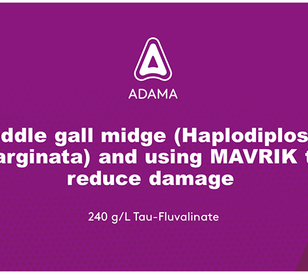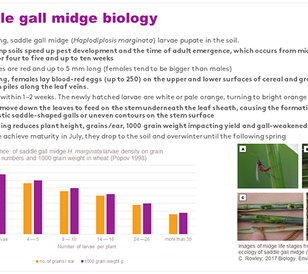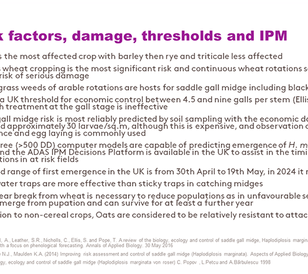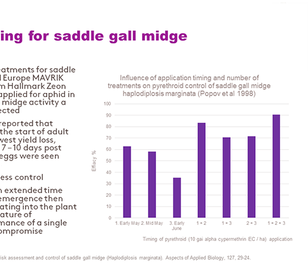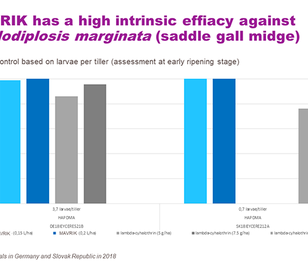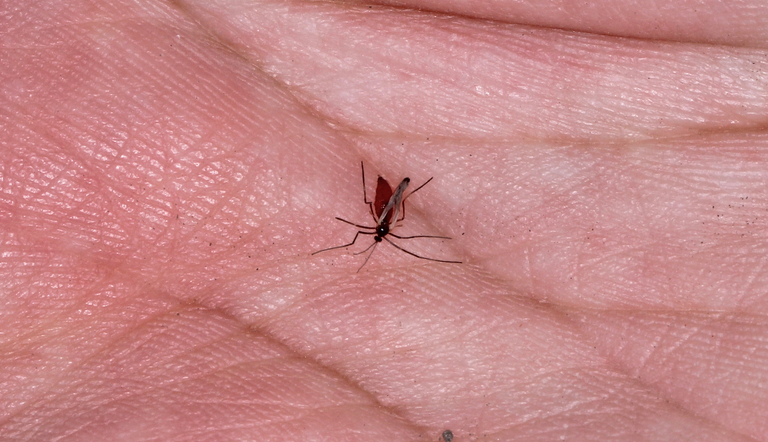
Saddle Gall Midge Warning

Saddle gall midge (Haplodiplosis marginata) infestations are sporadic in the UK, with some areas at greater risk than others. However, the latest crop action report from ADAS suggests that where this pest is present, the risk of emergence is currently classified as high.
The warm, damp soil conditions which continue to dominate throughout the UK will speed up midge development and make adult emergence easier: this typically starts in late-April and lasts for 5 – 6 weeks and potentially up to 10 weeks.
When the next spell of warmer weather arrives we can expect a large-scale emergence to coincide with when wheat crops are at their most vulnerable from GS31-39.
Adult midges are red in colour and typically up to 5mm long (females tend to be slightly larger than their male counterparts). After mating, the females will lay blood-red eggs (up to 250) on the upper and lower surfaces of cereal and grass leaves. These eggs will hatch within 1-2 weeks, with the new larvae turning from a white or pale orange colour to bright orange as they mature. They will then move to feed on the stem underneath the leaf sheath where they will cause characteristic saddle-shaped galls or uneven contours that show on the stem surface and are obvious when outer leaves are unrolled.
The impact of feeding results in shorter stems together with a reduced grain number and thousand grain weight proportionate to the number of larvae per stem. Net yield loss varies depending on midge numbers and wheat growth stage at infestation with potential for a crop right off in exceptional circumstances. In continental Europe, an assessment of the damage caused by saddle gall midge found that net yield losses of as much as 10% can be expected in unprotected crops. Gall-weakened stems will also be more susceptible to lodging.
Thankfully, the same trial work has shown that MAVRIK® (tau-fluvalinate 240g/L) performs well against saddle gall midge, often outperforming its main rival, lambda-cyhalothrin. Although there are no UK approved treatments for saddle gall midge, applying MAVRIK® at 0.15 l/ha to control cereal aphids also shows good control of midges. Therefore, in the event that red adult midges are spotted in wheat alongside active aphids, MAVRIK® is the ideal treatment choice.
Timing of treatments should be assessed on a by field basis. There is a UK threshold for economic control between 4.5 and nine galls per stem although treatment at the gall stage is ineffective. Ideally risk is most reliably predicted by soil sampling with the economic damage threshold approximately Saddle gall midge 30 larvae/sq.m, although this is expensive, and observation of adult emergence and egg laying is commonly used. In addition to visual crop inspections, water traps are proven to work well and there are pheromone traps from Agralan.
UK work by Ellis et al. (2014) reported that chemical controls applied at the start of adult emergence resulted in the lowest yield loss, although treatments applied 7 – 10 days post emergence or when the first eggs were seen also reduced larvae numbers.
